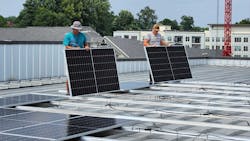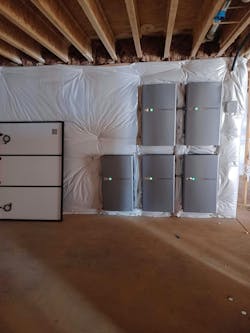In response to President Trump’s new 10% tariffs on Chinese goods, microgrid, battery storage and solar companies say they are working to source their materials outside of China, manufacture components in the U.S., keep projects on track and create more certainty for their customers.
They also said that the tariffs may slow but will not stop the renewable energy industry’s momentum.
Right now, solar panels from Chinese brands can be purchased for an average of 20% less than panels from other countries in spite of existing 7.5% tariffs, Ben Zientara, an industry and policy analyst at SolarReviews, told Microgrid Knowledge.
“The big worry here is escalation of trade tensions that could cause downstream problems,” he added. If China enacted an export ban on certain raw materials that go into making solar modules, U.S. producers could not acquire the components they need, he said.
“Any Chinese action toward restricting exports could have a negative effect on these manufacturers, leading to shortages and increased prices, which would in turn allow Chinese brands to remain competitive,” he said.
Some prefer alternatives to inflationary tariffs
To compete with China, rather than implementing tariffs, the U.S. should provide economic incentives for manufacturing in the U.S., some industry members said.
Kristel Watson, chief commercial officer at Scale Microgrids, said she understands the Trump administration’s desire for promoting domestic manufacturing and production, but prefers alternatives to tariffs.
“Tariffs are inflationary by nature,” she said. “They’re also quite blunt and can have strong impacts quickly, which can be challenging from a business perspective for managing schedules and keeping projects on track.”
Scale Microgrids hopes the administration looks at all opportunities for encouraging domestic production and manufacturing–including economic incentives–as long as they don’t create an administrative burden, Watson said. Some have argued that the Inflation Reduction Act’s (IRA) tax incentives create that burden.
Customers may wait and see, delaying projects
As a result of the tariffs, customers may wait to see if the tariffs get lifted, Watson said.
Danny Lu, senior vice president and founding member of Powin Energy, which offers utility-scale energy storage systems, said the biggest impact of the new tariff will be on energy storage projects that already have contracts in place.
“If you sign a contract, the cost of tariffs and shipping is fixed,” he said. “But the delivery of the projects takes 6 to 9 months.”
Between the time Powin receives an order and the time the order delivers, new tariffs could impact the cost of the total system, he said.
Who absorbs additional costs from tariffs?
“Customers or the supplier have to take on that increase, which affects profitability on both sides,” he said.
Often, the delays occur pre-contract, just as the company is bidding on a new project. If new tariffs are announced, customers might delay their decision while awaiting further announcements. This sparks indecision and causes projects to get pushed into the next year, Lu said.
Powin’s strategy is to find as many suppliers as possible producing cells in the U.S. and Southeast Asia, to assemble products in the U.S. and apply for manufacturing and tax credits from the IRA.
Under the IRA, if 50% of the product is domestic content, manufacturers of battery cells could get an extra 10% tax credit–in addition to the 30% investment tax credit, he said.
While purchasing cells from southeast Asia might be 10% to 15% more expensive than acquiring cells from China, the numbers likely will pencil out in 2026, when a 25% tariff on Chinese goods is a possibility, Lu said.
Powin is also working to deepen its relationship with its suppliers in ways that might provide more certainty to its customers, he said. The company might sign long-term contracts with suppliers and work with them to potentially absorb some of the risks of tariffs, which would help customers make decisions faster.
Working with suppliers to minimize risk
“The more we can work with suppliers to absorb some of that risk, it gives customers more confidence that projects economically will work,” Lu said.
“If tariffs get increased to 25% out of the blue, we could work with customers to find fallback options,” he said. That might include swapping the supply from China to Southeast Asia or pivot to domestic production. Powin has a memorandum of understanding with a partner to collaborate on a factory in Texas, where it plans to begin producing its Powin Pod battery pack in the first quarter of 2026.
The fear in the market has sparked companies to focus on Southeast Asian and domestic supply, which may ultimately be more expensive than acquiring battery cells in China. “But it’s a tradeoff between cost and risk,” he said.
For Matt Powers, founder of Virtue Solar, smaller residential solar companies like his don’t expect to see large price increases, in part because they shifted their manufacturing to other countries several years ago, he said.
Staying on the path in spite of the rollercoaster ride
“While the industry is certainly a rollercoaster, at the moment our distributors are expecting to see modest price increases, but nothing close to the volatility we saw during the pandemic,” Powers said. “We plan to continue operating as normal for now, and are keeping a positive outlook despite the rocky environment we're in.”
Even though that rocky environment creates uncertainty, Scale Microgrids is seeing “astronomical demand,” Watson said. Demand has picked up for electricity that’s reliable, able to separate from the grid and fill in utility supply gaps, she said.
“We are very positive looking on the outlook of all our deals in the renewable space and microgrid space as a whole,” Watson said.
About the Author
Lisa Cohn
Contributing Editor
I focus on the West Coast and Midwest. Email me at [email protected]
I’ve been writing about energy for more than 20 years, and my stories have appeared in EnergyBiz, SNL Financial, Mother Earth News, Natural Home Magazine, Horizon Air Magazine, Oregon Business, Open Spaces, the Portland Tribune, The Oregonian, Renewable Energy World, Windpower Monthly and other publications. I’m also a former stringer for the Platts/McGraw-Hill energy publications. I began my career covering energy and environment for The Cape Cod Times, where Elisa Wood also was a reporter. I’ve received numerous writing awards from national, regional and local organizations, including Pacific Northwest Writers Association, Willamette Writers, Associated Oregon Industries, and the Voice of Youth Advocates. I first became interested in energy as a student at Wesleyan University, Middletown, Connecticut, where I helped design and build a solar house.
Twitter: @LisaECohn
Linkedin: LisaEllenCohn
Facebook: Energy Efficiency Markets


